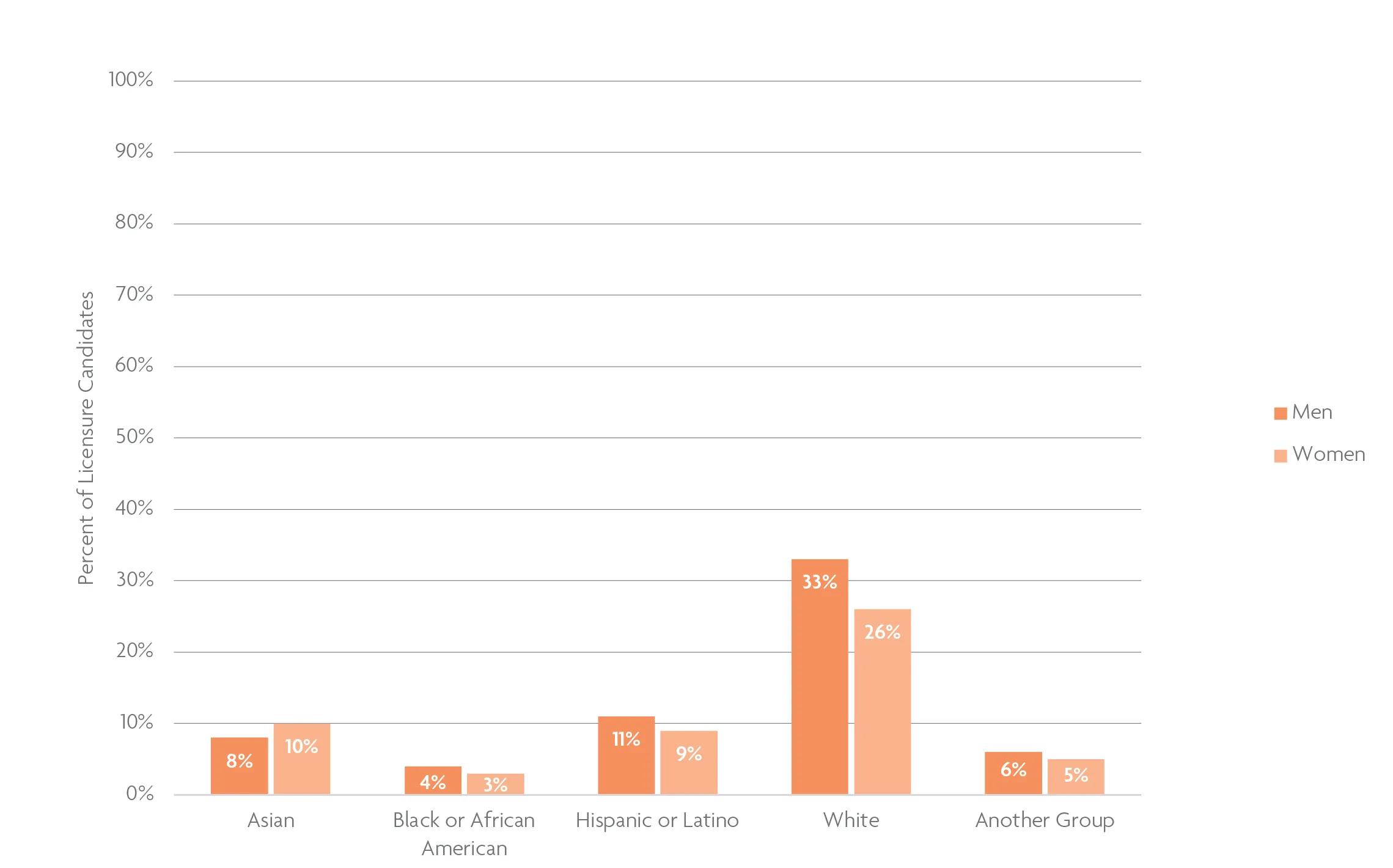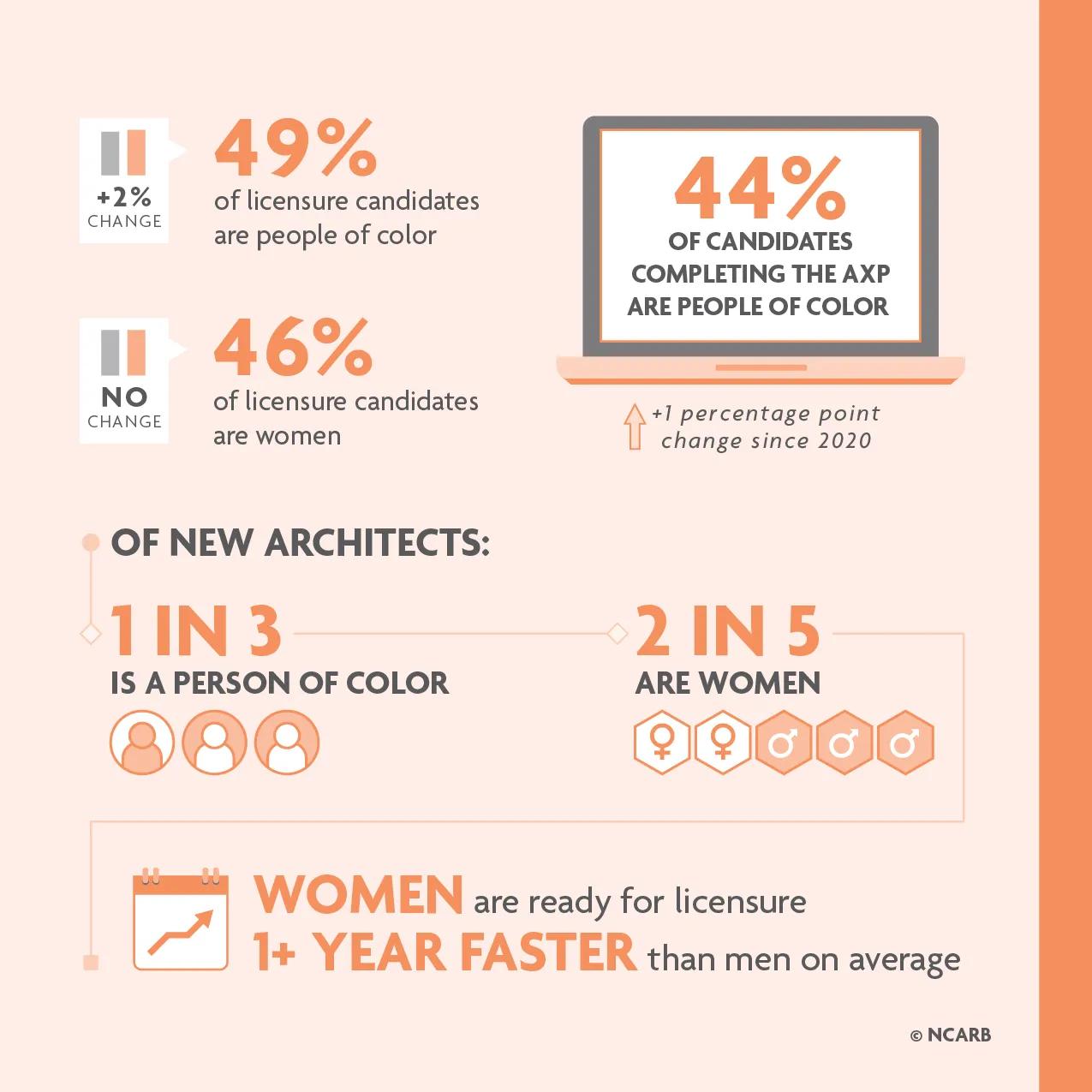
Over the past several years, NCARB has implemented several changes to improve accessibility on the path to licensure—with the ultimate goal of improving representation among licensed practitioners. Greater diversity in the candidate population is beginning to make its way to the pool of licensed architects:
In 2024, 1 in 5 architects identified as a person of color.
NCARB has seen continued growth in gender equity and racial diversity across all licensure candidate stages, from creating an NCARB Record to completing the ARE, over the past 5 years. In 2024, racial and ethnic representation among candidates hit a record high, with nearly half (49%) of candidates identifying as a person of color. Additionally, 46% of licensure candidates are women, including 51% of new Record holders. As candidates progress along the licensure path, these increases are becoming more and more apparent in the profession.
Women make up 47% of the testing population and typically earn their licenses faster than men—completing requirements more than a year sooner on average. In 2024, 44% of candidates completing the AXP and 33% of candidates completing the ARE identified as a person of color.

20% of architects identify as a person of color.
NCARB has seen steady growth in representation within the architect population over the past decade. The proportion of architects who identify as a person of color (POC) rose by 1 percentage point in 2024. People of color now make up 20% of the total architect population, 4 percentage points higher than the proportion seen 5 years ago. While white architects still make up a majority of the population, increased diversity in the candidate pool is slowly filtering into the pool of licensed practitioners.
DID YOU KNOW? “People of color” includes anyone who identifies as a race or ethnicity other than white. Because individuals can identify as part of more than one racial or ethnic group, these percentages can add to more than 100%.
More than a quarter of architects are women.
In 2024, 27% of the architect population identified as a woman, the same proportion seen in 2023. Like racial and ethnic representation, gender representation has shown a slow-but-steady increase over the past several years: Women now make up 3 percentage points more of the architect population than they did in 2020.
According to NCARB’s Record holder data, less than .02% of the architect population identifies as nonbinary, approximately 20 individuals. NCARB’s threshold for minimum sample size is 30 individuals. NCARB began offering nonbinary gender options within customer Records in 2023, so this proportion could shift upward over time as more Record holders make use of the updated field.
Racial and ethnic diversity among architects holds steady.
Racial and ethnic representation in the architect population did not change between 2023 and 2024: Asian and Latino architects continue to make up 7% each of the total architect population, with Black or African American architects representing another 2%.
While most underrepresented demographic groups have seen slight increases over the past 5 years, Black or African American representation has remained unchanged.
WHAT IS "ANOTHER GROUP?" “Another group” includes architects who identify as any group that is too small to include on its own, as well as those who self-identify.
White men make up 3 out of every 5 architects.
White men have historically been the most represented demographic within the architect population; in 2024, they made up more than 60% of all U.S. architects. White women are the second-most represented group, making up 20% of the total architect population.
Representation for other demographic groups has slowly improved over the past several years. In 2024, women of color comprised 8% of the architect population, and men of color comprised 13%—1 percentage point more each than in 2023.
DID YOU KNOW? NCARB uses the NCARB Certificate holder population as an approximation for the architect population.
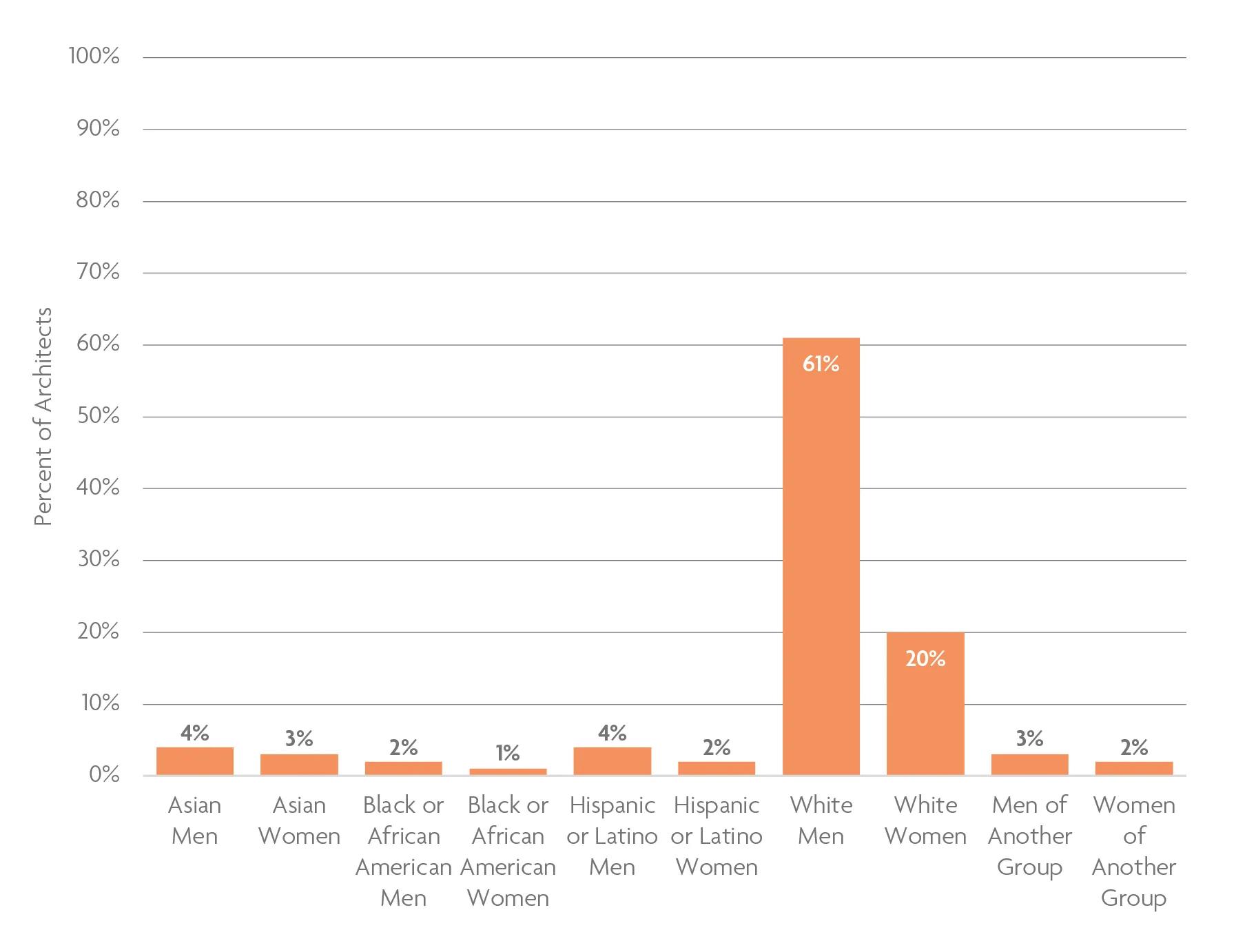
New architects are more diverse than the overall architect population.
While diversity in new architects slowed in 2024, representation has followed an upward trend over the past 5 years. More than 2 in 5 new architects are women, and a third are people of color—
an increase of 2 and 4 percentage points, respectively, compared to 2020.
As the current cohort of candidates earn their licenses and become architects, NCARB expects to see representation continue to increase in the new architect population.
Asian candidates consistently become licensed faster than their peers.
The average Asian candidate who completed the licensure path in 2024 took 11.7 years to do so. This is approximately 1 year faster than the average white candidate, who are typically the next fastest to complete the path to licensure. In comparison, Black candidates took the longest at approximately 14.5 years.
Note: Because the sample size for underrepresented demographic groups is much smaller, the average time to licensure for these groups tends to fluctuate more significantly from year to year. Time to licensure data can also shift from previously reported numbers as candidates backdate experience or document additional information.
Women consistently earn their licenses faster than men.
Historically, women have completed the path to licensure in less time than their male peers, a trend which continued in 2024. The average woman who completed the path to licensure in 2024 took 12.1 years to do so, more than a year faster than the average man. For both men and women, the average time to licensure fell by 6 months compared to the average time seen in 2023.
Nearly half of licensure candidates are people of color.
Over the past 5 years, diversity among candidates pursuing licensure has continued to increase.
Just under half (49%) of licensure candidates in 2024 identified as a person of color—a new record for racial and ethnic representation in the candidate community. Representation in the community of licensed practitioners could increase in the years ahead as these candidates make their way into the architect population.
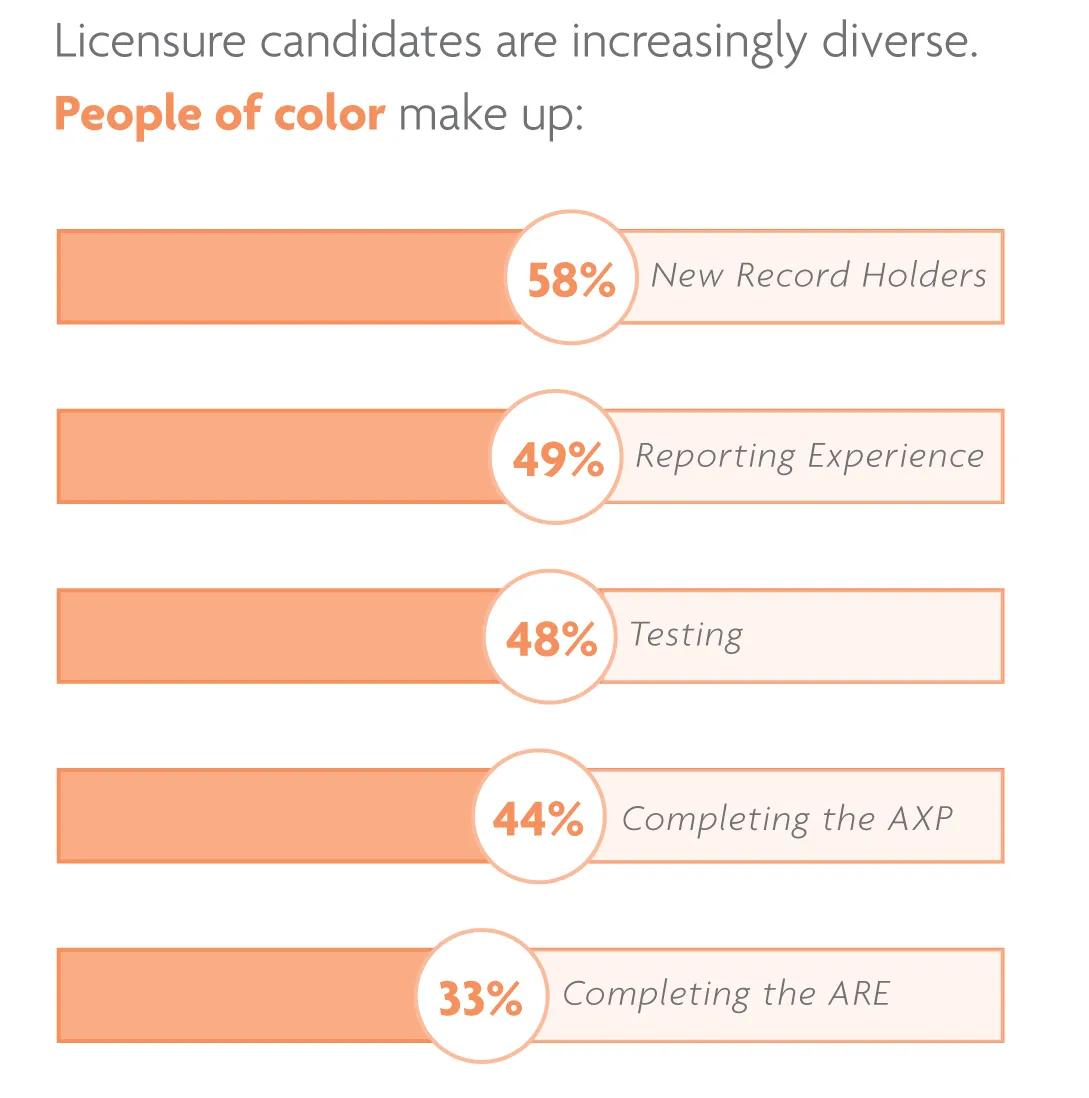
Gender representation among licensure candidates holds steady.
In 2043, 46% of the population of licensure candidates were women—a 3 percentage point increase since 2020. The licensure candidate population has been steadily approaching gender parity over the past decade. This trend reflects the increase in women pursuing careers in the architecture, engineering, and construction industry. It also highlights the impact of continuous work to promote greater equity and diversity within the architecture profession.
Currently, .17% of licensure candidates have self-identified as nonbinary—the first time that this demographic has crossed NCARB’s minimum sample size threshold of at least 30 individuals.
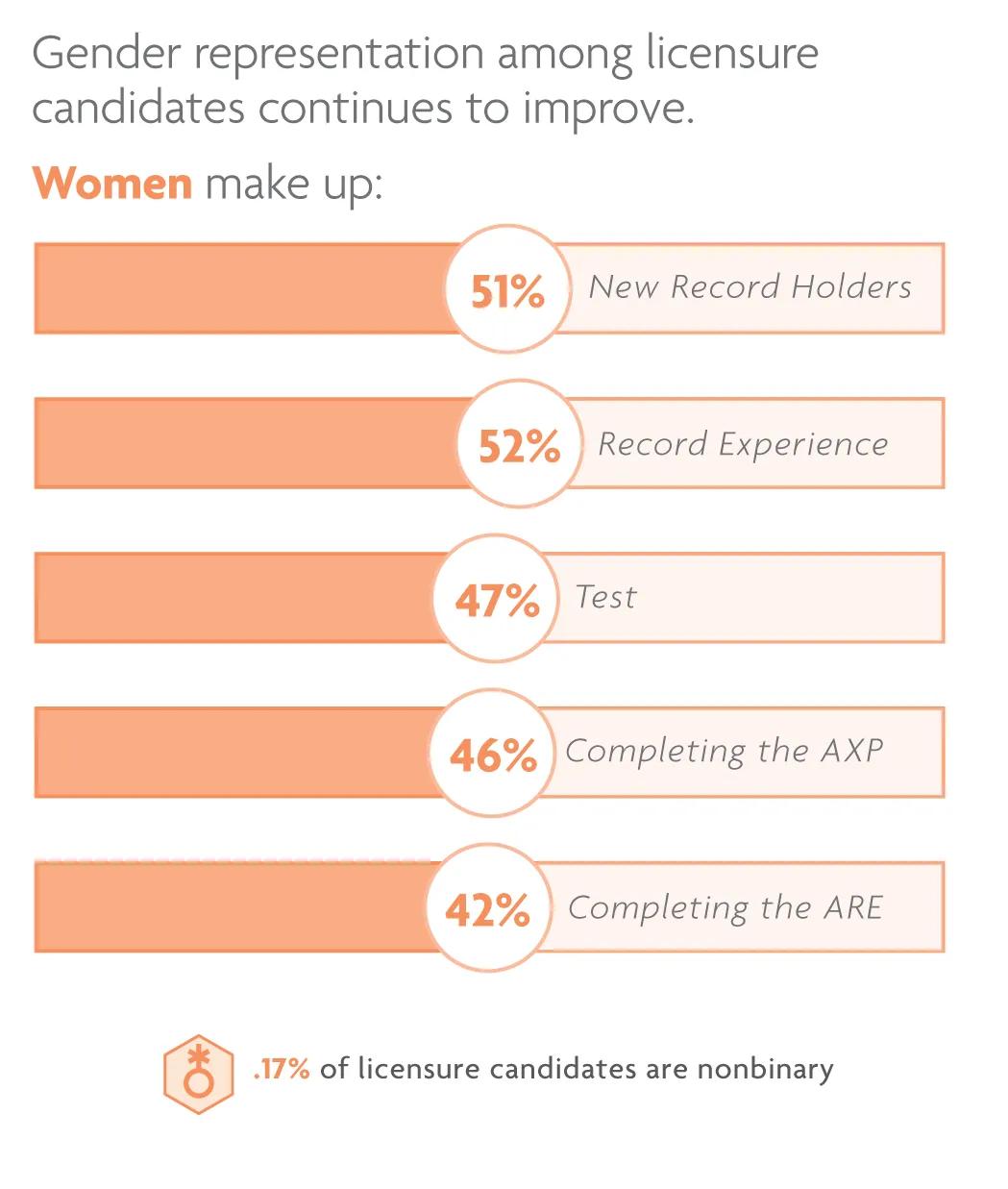
Latino representation among licensure candidates continues to grow.
White candidates remain the most represented group, making up 58% of all licensure candidates. However, representation continues to improve for other racial and ethnic groups. In 2024, 1 in every 5 licensure candidates identified as Hispanic or Latino—a record high and a 3 percentage point increase since 2020. Growth has been slower for Asian candidates, who made up 17% of the total candidate population in 2024, as well as Black or African American candidates, who made up 6%—a 1 percentage point increase over the past 5 years for both groups.
One third of licensure candidates are white men.
While white men continue to be the most represented group of licensure candidates, making up 33%, people of color now make up nearly half of the candidate population at 49%. Of candidates of color, Latino men and Asian women were the most represented groups, making up 11% and 10% of the population, respectively. While Black or African American men (4%) and women (3%) continue to be one of the most underrepresented groups of the licensure candidate population, the proportion of licensure candidates who are Black men has seen some growth compared to 2023.
